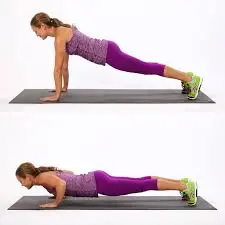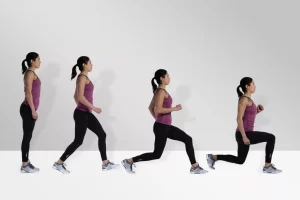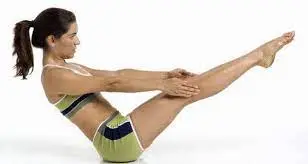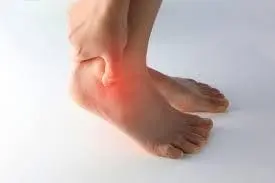Interval Training
Interval training is most commonly utilized combined with traditional cardiovascular workouts such as running, rowing, cycling, and swimming to push yourself harder than you could in a constant effort. Interval training programs set the desired training responses by varying the duration, intensity, and timing of the work intervals and rest periods.
A full interval training program usually includes several short, alternating periods of both higher and lower-intensity workouts. Initially called Fartlek (a Swedish term representing “speed play”), interval training incorporates alternating short and fast bursts of intense training with slower, easier movement. Fartlek training was an intended attempt to achieve more work than continuous training by raising the intensity of workouts.
Since then, interval training has developed into a more advanced and organized method for expediting your fitness program. Interval training alternates between periods of activity and recovery, in contrast to Fartlek training, which results in a transient build-up of lactic acid. Recovering from a fitness program involves continuous movement to aid in the excretion of waste products such as lactic acid.
Programs for interval training are also specifically and scientifically created for particular athletes. Trainers and physiologists record exact activity intervals that correspond to an athlete’s sport and current fitness level. Anaerobic threshold (AT) testing, for example, is typically used to determine the duration and intensity of these bursts of activity. It also measures the athlete’s blood lactate levels during intense exercise.
What is Interval Training?
The foundation of interval training is the alternation of brief, high-intensity sprints with more gradual recovery phases during a single exercise session. Athletes have been using interval training to increase their fitness for years. To increase their speed and endurance, athletes now use high-intensity interval training (HIIT) and more structured interval training regimens.
The fundamentals of this variation on fartlek training remain the same, whether it is a basic or complex routine involving interval training and speed work. Athletes can receive highly customized and structured training through interval workouts, tailored to their sport, event, and current conditioning level.
The results of anaerobic threshold testing (AT), which measures an athlete’s blood lactate during intense exercise, may even be used to design an interval training program. Less structured interval training, however, is still advantageous for the general public and non-competitive athletes.
How Does Interval Training Work?
Both the anaerobic and the aerobic systems are worked during interval training. The anaerobic system uses the muscle’s glycogen stores for brief bursts of energy during high-intensity exercises. Without oxygen, anaerobic metabolism can function, but lactic acid is the byproduct. The athlete experiences an oxygen deficit as lactic acid accumulates, and the heart and lungs cooperate to “payback” this oxygen debt and eliminate the lactic acid during the recovery phase.
During this stage, the aerobic system uses oxygen to produce energy from stored carbohydrates. It is believed that the body adjusts and burns lactic acid more effectively during exercise when high-intensity intervals that cause lactic acid are performed during practice. It also means that athletes can work out for longer periods at a higher intensity before becoming fatigued or experiencing pain.
Interval training works repeatedly on the anaerobic and aerobic systems during periods of high activity.
- To fuel brief spurts of activity without requiring oxygen, the anaerobic system metabolizes glycogen, the energy stored in muscles.
- As a byproduct, lactic acid accumulates, and the athlete is deprived of oxygen.
- The heart and lungs cooperate to supply this oxygen and to break down the lactic acid while the body is then left to heal.
- Subsequently, the aerobic system assumes control and releases stored energy from carbohydrates using oxygen.
Benefits of Interval Training
Interval training follows the adaptation principle. Numerous physiological changes are brought about by interval training, such as an increase in cardiovascular efficiency, the capacity to carry oxygen to the working muscles, and a greater ability to withstand lactic acid accumulation. Increased endurance, speed, and performance are the effects of these modifications.
- Increased endurance: Interval training makes all other exercises easier by teaching your heart to pump more blood to your muscles and your muscles to extract oxygen more efficiently.
- Exercises that are faster and more effective: If you are short on time, interval training is a great way to save time. They enable you to accomplish a lot in a brief period. If you want to work out quickly in and out of the gym, this is the kind of exercise you should do. In as little as 15 to 20 minutes, the entire session may be completed.
- Risks of injury and overtraining are reduced, You might be able to prevent injuries or overtraining by changing up the intensity of your workout.
- Weight loss: Studies reveal that interval training, even at a low intensity, can increase fat burning and boost calorie burn even after a workout is over.
- The Pleasure Factor: Due to their greater variety, interval exercises are less monotonous and repetitive than other types of exercise.
Two Basic Types of Interval Training
Even though there are countless ways to create an interval training program, there are two fundamental categories into which they can all be placed.
The Fitness Interval Training
Beginners and intermediate exercisers should use this technique. With this training approach, there are intervals of higher intensity (60% – 85% heart rate reserve) that typically last two to five minutes, interspersed with lower intensity intervals of the same length.
The Performance Interval Training
More experienced athletes are advised to use this advanced technique. With this training approach, there are intervals of maximal intensity (85% to 100% heart rate reserve) that typically last two to fifteen minutes, interspersed with shorter or equal intervals of lower intensity.
Common Types of Interval Training Exercises
The exercise illustrations below show how easily interval training plans can be modified to fit the needs of most sports or activities. It is possible to achieve specific training responses by varying the length of the rest periods and the intensity and duration of the work intervals.
- Jump Rope is a quick and low-cost method of increasing general fitness. They can increase muscular strength, endurance, balance, agility, and cardiovascular fitness in addition to burning calories.
- A 30-second Run Drills provide the same benefits as long, slow cardio in about half the time, which helps to increase aerobic capacity and fitness quickly.
- Rapid and Accelerated Training Exercises that combine speed and endurance are beneficial for all sports. Only begin once you have completed three months of regular exercise and have attained a level of fitness training where you can run for twenty to thirty minutes at a time.
- Training for Explosive Exercises Another technique to gain strength and power is through routines. used by top athletes in sports like sprinting and jumping, which call for quick bursts of maximal effort in a brief period.
- Agility drills help athletes become more coordinated, faster, stronger, and more adept at sports. Sports technique is improved and foot speed is perfected with these drills.
- A common agility and speed exercise for players in stop-and-start sports like basketball, soccer, hockey, and tennis is the shuttle run.
- A challenging exercise that improves cardiovascular fitness, speed, and power is stair running. Because of its agility, foot speed, and great sprint workout, this is a great addition to any agility training program.
- Many athletes and trainers use plyometric jumping exercises to improve agility, coordination, and athletic power (strength and speed) for improved sports performance.
- Tuck Jumps are basic exercises designed to improve an athlete’s dynamic power and agility, thereby raising their vertical leap. used to improve one’s ability to jump long, box, high, and vertical.
What Makes This Type of Training So Effective?
Beginners, intermediate exercisers, and well-conditioned athletes can all benefit from interval training. Increasing exposure to more intense training without becoming overly fatigued is made possible by interval training. By forcing the body to adjust to the new process, intense repetition encourages the athlete’s body to respond. There are numerous advantages to this:
- To strengthen the muscles, especially the heart muscle, new capillaries are formed to carry oxygen to them.
- Athlete well-being and performance are greatly enhanced when stronger muscles that can withstand lactic acid accumulation are combined with an enhanced cardiovascular system.
- Long-term, repetitive exercise reduces injuries because there is less risk of overtraining or burnout.
- There is a gain in overall aerobic power and fitness.
- beneficial when attempting a new activity or type of exercise. makes it possible for you to increase your level of engagement with the continuous activity gradually and effectively without becoming too tired.
How to Build Interval Training Workouts
The appropriate interval training regimen can be created elegantly or informally. The ideal interval training regimen may be determined for professional athletes by having blood lactate and exercise metabolism tested at a sports performance lab. Conversely, you can use interval training (fartlek) for casual “speed play” without timing.
Your goals will determine how long you work and how long you recover. When creating your interval training program, you have four variables to work with:
- Work interval duration (distance or time)
- The duration of the recovery or rest period
- Speed or intensity of work interval
- The number of times each interval is repeated
Interval types:
- Longer recovery periods: You can push yourself harder during the work interval when you combine a longer recovery period with a shorter work interval. A 30-second sprint followed by a 1-minute recovery, for instance.
- Longer work intervals: As you progress, you can shorten the rest and increase the work interval. More calories are burned and endurance is increased by doing this.
- Mixed work intervals: You can change the duration and intensity of your workouts by dividing the work intervals into segments that are either shorter or longer than the others, or by having some at the maximum effort and others at a moderately high effort.
- Untimed intervals: Just like with fartlek you just adjust the intensity and duration based on how you’re feeling.
Gradually increase the number of repetitions. To get better, up the duration or intensity, but not both at once. It is best to put in any changes gradually over time. Beginners should begin with shorter workouts (less than 30 seconds), fewer repetitions, and longer rest periods. Training volume, frequency, and intensity can all be increased by elite athletes. Interval training is beneficial for very few athletes when done more than twice a week.
Aerobic Interval Training (AIT)
In aerobic interval training, you alternate between work intervals of moderate to high intensity and recovery intervals. It is less than 85% of your maximum heart rate that you are working at. During the rest interval, try to recover so that your heart rate drops to between 100 and 110 bpm.
Any aerobic exercise is suitable, including elliptical training, walking, jogging, and cycling. After at least five minutes of warm-up, the workout can last as little as ten minutes, or for the more experienced, up to sixty minutes.
Shorter work intervals and longer recovery intervals may be used by beginners. The length of the work and recovery intervals can be changed as fitness increases, up to ten minutes for the work intervals and two minutes for the recovery intervals.
Here is a standard Aerobic Interval Training workout:
- Warm up at a comfortable level of exertion for five to ten minutes.
- For two to three minutes, increase your pace or level of effort to your recovery level.
- For one to two minutes, up the speed or difficulty to reach a higher heart rate zone, but stay within 85% of your maximum heart rate.
- For two to five minutes, go back to your recovery pace or level of effort.
- As needed, repeat the recovery and work intervals for the duration of your chosen workout.
- Aerobic interval training is an activity you can do twice a week or more.
Anaerobic or High-Intensity Interval Training (HIIT)
During anaerobic interval training, your heart rate is raised to 85% to 100% of your maximum heart rate during the work interval. You can use any aerobic exercise that can raise your heart rate to the anaerobic zone, like cycling or jogging. Because these workouts are so intense, they are typically completed in less than 20 minutes, starting with a warm-up.
Typically, the rest interval doubles the duration of the work interval. For example, a 30-second sprint is followed by a 1-minute recovery period. A longer warm-up, perhaps ten to fifteen minutes, is preferable to shorter, less intense intervals. Give yourself 24 to 48 hours to recover between HIIT workouts because of their intensity.
An example of an anaerobic interval workout:
- After 5 minutes of easy-to-moderate warming up, increase your effort to your recovery interval for an additional 5 minutes.
- Work interval 30 seconds: Run as quickly and strongly as you can.
- starting your recovery interval effort after one minute of rest is recommended.
- Work and rest periods should be repeated three to seven times.
- Cool down for five minutes at a light effort to complete it.
10 Best Interval Training Exercises
Interval Workouts
The best part about adding interval training into your daily fitness routine is that it allows you to quickly increase your strength and endurance. These fantastic interval exercise options can be combined to create a 20- to 30-minute routine. The common exercises you already know like cycling, running, and treadmill training. so, here we discuss some other exercises to apply in your routine.
Start with a 5-minute warm-up and progress into brief, high-intensity intervals for a quick and efficient workout. The duration of each interval can range from 30 to 2 minutes, with one minute of easy walking in between each rep. After about 20 minutes, stop and let it cool.
The following interval exercises have benefits and instructions listed below: pull-ups, push-ups, walking lunges with weights, v-sits, dumbbell squats to press, burpees, shuttle sprints, jump rope, and stair running.
Jumping Rope

Adding high-intensity interval training to your workout program is easy and affordable if you get a jump rope. Properly executed, jumping rope can enhance strength, agility, balance, and cardiovascular fitness. You will burn some calories and feel the burn when you perform single jumps for a minute or two.
Stair Running
All you need is an incline of stairs to get an amazing interval workout—all you need is time and equipment. Running and its cardiovascular benefits are comparable. Building phase power on the stairs is a great idea.
Burpees

Burpees are becoming popular again. Your entire body, especially your cardiovascular system, is quickly worked out by this straightforward but effective exercise. Take an upright position at first, then lower yourself to a squat and place your hands on the floor in front of you.
Return your feet to the push-up position quickly. For a challenging workout, do a push-up while you’re here. Alternatively, you can simply land a high jump, return to the starting position with your feet, and repeat. If you want to make sure you are performing a burpee correctly, watch one.
Shuttle Sprints

A common warm-up exercise for athletes who play stop-and-go sports like soccer, hockey, basketball, and tennis is the shuttle sprint. You just need to place two markers roughly 25 yards apart to begin shuttle sprints.
One repetition consists of sprinting from one marker to the other and back. Aim for ten sprints in a row. The shuttle sprints can be performed side-to-side, forward, and backward.
Spinning

If you sign up for a spin class, you will probably perform some high-intensity spin intervals. However, you can design your interval training during off-peak hours by using a home trainer or going to a spin class.
The workout will go by quickly if you combine the bike with some other bodyweight exercises. One of the most well-liked indoor exercise options is riding a stationary or spinning bike, which offers a low-impact, high-intensity cardiovascular workout while also enhancing strength and endurance.
Dumbbell Squat to Press
Weights are a simple way to increase the intensity of an exercise routine. For a full-body workout, try dumbbell squats and overhead presses, which target your arms, shoulders, core, quadriceps, and glutes.
Place your feet hip-width apart as you stand. With your elbows bent 90˚ and your palms facing forward, hold a dumbbell by each shoulder. Drive back up explosively and press the weights overhead until your arms are fully extended after lowering yourself into a squat until your thighs are parallel to the floor.
Pull Ups

This exercise requires some basic equipment or creativity, the pull-up exercise is a great, simple way to develop upper body strength. Your feet should hang freely, and the pull-up bar should be high enough that you have to jump to grab it.
Place your feet shoulder-width apart as you stand below the bar. Jump to your feet and grasp the bar with an overhand grip that is shoulder-width apart. Stretch your arms to the limit and hang there.
For a balanced posture, bend your knees and cross your ankles. Breathe in at the bottom. Pull yourself up until your chin is level with the bar and release the air. At the top, pause. As you descend, inhale and raise yourself until your elbows are straight. Continue the motion without contacting the ground. Perform as many repetitions as your workout requires.
Push Ups

Standard push-ups are simple, equipment-free total body exercises that strengthen the upper body and core. Exercise your triceps, back, shoulders, abs, and hips with this compound exercise, which should be done slowly.
Getting on all fours and spreading your hands slightly wider than your shoulders is how you perform a push-up on the floor. Bend the elbows slightly, but avoid locking them out. Legs extended back, place your feet hip-width apart, and maintain balance on your hands and toes.
Once you’re in this position, here’s how to perform a push-up. Pull your belly button in the direction of your spine to clench your abs and tighten your core. Breathe in while lowering your body to the floor and progressively bending your elbows until they are 90 degrees. Breathe out tighten your chest muscles and raise yourself back up using your hands to take the initial position.
Walking Lunge With Weights

You will improve your strength, balance, and endurance by including walking lunges. For nearly all types of athletes, this exercise has enormous benefits. If you are uncomfortable lifting a weight above your head when performing a walking lunge, start with an empty barbell or broomstick and work your way up to the heavier weight.
Try walking lunges to test your balance even more and to get an extra cardio boost. Raise your arms straight and hold your dumbbells at your sides while standing tall. Lifting your chest, extend one leg forward and bend the front knee until the back knee nearly touches the floor.
V-Sit Abdominal Exercise

Consider your routine complete after working your abs for a minute or two. An intense core exercise that works the rectus abdominis, external obliques, and internal obliques is the v-sit. Hip flexors are also worked during this exercise.
Start by sitting with your feet and hands flat on the floor. As you slowly contract your core and abdominal muscles, raise your legs to an extended position at a 45-degree angle with your torso.
As far as you are able, extend your arms straight forward or upward towards your shins. Throughout the exercise, it’s critical to keep your spine strong, your core in good alignment, and your shoulders from rounding forward. Breathe deeply throughout the movement; don’t hold your breath. Start by holding this V-shaped position for a few seconds.
As you gain strength, extend the duration of the hold. Maintaining your abs’ tightness and engagement, slowly return to your starting position. Stop just short of the floor and maintain the pose for a brief period. Do this entire movement at least 10 times.
What are the four steps to schedule an individualized interval training program:
The four steps to create personalized interval training are:
- Determine interval intensity based on training goals
- Determine interval duration
- Determine recovery intensity
- Determine recovery duration
Step 1: Determine interval intensity
Choosing the intensity of your intervals is the first step. The particular training objective should determine the interval intensity. Would you like your VO2max to rise? perhaps boost the anaerobic power? Or Make sure to base the intensity of your intervals on your desired outcome, whatever it may be. For example, it makes no sense to base the interval intensity on %FTP or %AT (anaerobic threshold) if your goal is to raise your VO2 max. Interval intensity should instead be determined by aerobic energy contribution or VO2 max.
Methods to measure the intensity of interval training:
Power meters, perceived exertion scales, and heart rate monitors can all be used to help you determine the right levels of intensity. While this guide applies to any goal, our main focus will be on interval training to increase anaerobic power (VLamax). We need an interval intensity at a high percentage of VLamax (requiring a high anaerobic energy contribution in addition to high anaerobic power) to increase anaerobic power.
Step 2: Determine interval duration
Duration and intensity are exactly what describes an interval. The duration of your intervals should be decided upon after you’ve established their intensity.
How Long should intervals be?
Athletes’ goals and recovery abilities can help coaches and labs decide how long interval training sessions should last for their athletes. The intensity was calculated using our target (%VLamax). The anaerobic system’s energy contribution decreases with the length of time. On the other hand, very little anaerobic energy is used if the interval is too short in duration. We therefore keep using a 20-second interval length. If you work as a sports coach or lab, you are aware of the importance of interval training in enhancing athletic performance.
Step 3:Determine recovery intensity
Interval training’s recovery phase is just as essential as its on-phase. Our interval training’s training effect is determined by recovery. Anaerobic energy contribution gradually decreases as a result of incomplete recovery (e.g., too brief or at an excessively high intensity). For our example interval training, which aims to increase VLamax, or anaerobic power, is not what we want.
Step 4: Determine recovery duration
Choosing the recovery duration is the last step in designing your interval training. The length and intensity of your intervals, as well as the intensity of your recovery, will determine how long it takes to recover. The final step is very simple to follow. Our example athlete will accumulate 13 mmol/l lactate per minute during the interval, according and the lactate accumulation & recovery graph. In our 20-second interval, that translates to a lactate accumulation of 4.3 mmol/l.
The lactate accumulation and recovery indicate that, at the chosen recovery intensity, our exemplary athlete will only recover 0.36 mmol/l lactate per minute. After completing our 20-second interval at 40% of VLamax, our athlete needs to recover for a total of 12 minutes at a moderate speed of 130–145 watts (1.3–1.6 m/s).
How are interval training sessions designed?
Nearly every aspect of interval training can be specific to the individual. The plan is to schedule work to active-recovery ratios (work:active-recovery) at minute-by-minute intervals.
Let’s take an example where you typically work out on the treadmill at a comfortable pace of 6 mph. Thus, following a brief warm-up and several minutes of 6 mph running, you sprint for one minute at 7.5 mph and then jog for three more minutes at 6 mph (1:3 ratio: a total of four minutes). After completing your workout in full with these intervals, you cool down for approximately five minutes.
How do I determine how hard to work?
Heart rate is an easy way to measure and a good indicator of how hard you’re working, making it a great tool for interval setup and monitoring. This is a demonstration. Assume that, at a 6-mph jog, your heart rate is 70% of your anticipated maximum. You warm up and run at that pace for a few minutes, then you ramp up to 7 mph for your work interval (which could be 85% or even 90% of your maximum heart rate). For your active recovery, you then decrease the speed to 6 mph, which is 70% of your maximum heart rate.
This is an example of a 28-minute interval training program (warm-up and cool-down excluded). Remember that you can complete all of the work intervals in this example, or you can switch it up and only complete some of them. The duration of each interval in this example always adds up to four minutes.
Sample HIIT Workout
- Warm-up: 5 minutes at 5-6 mph
- Interval 1: 3 minutes at 6 mph (70% of max heart rate)
- Interval 2: 1 minute at 7 mph (80% of max heart rate)
- Interval 3: 3 minutes at 6 mph
- Interval 4: 1 minute at 7 mph
- Interval 5: 3 minutes at 6 mph
- Interval 6 – harder: one minute at 7.5 mph
- (85% of max heart rate)
- Interval 7: three minutes at 6 mph
- Interval 8: one minute at 7.5 mph
- Interval 9: three minutes at 6 mph
- Interval 10: one minute 7.5 mph
- Interval 11: three minutes at 6 mph
- Interval 12: one minute 7.5 mph
- Interval 13: three minutes at 6 mph
- Interval 14: last push — one minute at 8 mph (90% of heart rate max)
- Cool down: 5 minutes at 5-7 mph, then start walking
Some athletes work out at their maximum heart rate of 100%. Active-recovery ratios of 1:3 and 85%–90% are the recommended starting points for beginners, and I don’t advise going above that. Keep in mind to stay properly hydrated the entire time you exercise.
Interval Training Precautions and Safety Guidelines
The most frequent issue with interval training, despite its great benefits, is that individuals often overdo it by pushing themselves beyond their comfort zone due to the intense nature of the exercises. Overtraining, a higher chance of injury, and sore muscles and joints are the usual outcomes. You should consider the few safety measures listed below.
- Determine a reasonable training objective that fits your existing level of fitness.
- Perform a safe warm-up before beginning your interval training.
- For better results, start slowly and work your way up to longer intervals.
- Keep up a moderate but demanding pace the entire interval.
- Improve the repetitions over time.
- Decrease your heart rate to 100-110 bpm during the rest interval.
- To step up your fitness levels, improve the intensity or duration, but not both at once.
- Extend any gains slowly over some time.
- Make sure to exercise on even, smooth surfaces. You should also schedule regular flexibility and stretching exercises into your fitness regimen. You must have supple and flexible muscles and joints to handle the added intensity of interval training.
FAQ
Can you lose fat with interval training?
People who want to lose weight can benefit greatly from high-intensity interval training (HIIT) because it increases calorie burn, lowers body fat, and enhances overall health. Similar advantages to other forms of intense training and exercise can be obtained from HIIT.
Who puts interval training into practice?
The Interval Training for Fitness
It is advised that beginner and intermediate exercisers use this technique. This type of training alternates between higher-intensity intervals (60–85% heart rate reserve) lasting two to five minutes, and lower-intensity intervals lasting the same amount of time.
What drawbacks exist with interval training?
Loss of power, endurance, speed, or other performance-related factors.
appetite decline.
difficulty getting a good night’s sleep.
persistent soreness or aches.
respiratory infections or recurring colds.
injury from overuse, such as tendonitis.
unusual exhaustion.
Which time of day is ideal for interval training?
The best time of day to do HIIT is in the morning if you want to get the most out of it. This is so that you can give it your all because your body will be rested and renewed! Additionally, HIIT exercise in the morning may increase your metabolism throughout the remainder of the day.
What is interval training’s primary advantage?
Along with other advantages, interval training can help runners increase their level of fitness, reduce body fat, and quicken their pace. Steady-state runs have their place and time.
What heart rate is ideal for interval training?
Your maximum heart rate during exercise can be roughly estimated by deducting your age from 220. To improve your cardiovascular fitness, you only need to exercise at 60% to 70% of your estimated maximum heart rate. Your gains in fitness will be even more apparent if you can condition your way up to 80%.
References
- Walker, B. (2023, February 15). Interval training. StretchCoach.com | Stretching and Flexibility. https://stretchcoach.com/articles/interval-training/
- Ms, E. Q. (2022b, October 16). Interval training workouts build speed and endurance. Verywell Fit. https://www.verywellfit.com/interval-training-workouts-3120774
- Cde, R. W. M. (2021, July 19). Interval training exercises, examples, running, benefits, plan. MedicineNet. https://www.medicinenet.com/interval_training/article.htm
- Ms, E. Q. (2022b, September 30). 10 best interval training exercises. Verywell Fit. https://www.verywellfit.com/best-interval-training-exercises-3120602
- Falk, M. (2022, November 2). Your complete guide to interval training. Shape. https://www.shape.com/what-is-interval-training-6824249
- Makarov, I. (2023, July 20). How to create highly effective interval training: 4 steps. INSCYD. https://inscyd.com/article/how-to-create-effective-high-intensity-interval-training-4-steps/








One Comment